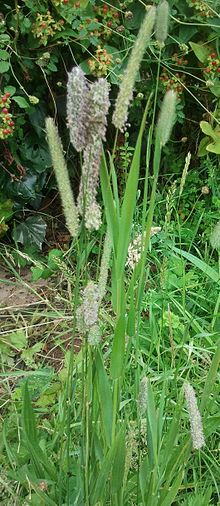Timothy-grass
| Timothy-grass | |
|---|---|
 |
|
| Habitus, ssp. pratense | |
| Scientific classification | |
| Kingdom: | Plantae |
| (unranked): | Angiosperms |
| (unranked): | Monocots |
| (unranked): | Commelinids |
| Order: | Poales |
| Family: | Poaceae |
| Genus: | Phleum |
| Species: | P. pratense |
| Binomial name | |
|
Phleum pratense L. |
|
Timothy-grass (Phleum pratense) is an abundant perennial grass native to most of Europe except for the Mediterranean region. It is also known simply as timothy, or as meadow cat's-tail or common cat's tail. It is one of the Phleum genus, consisting of about 15 species of annual and perennial grasses.
It is probably named after Timothy Hanson, an American farmer and agriculturalist said to have introduced it from New England to the southern states in the early 18th century. Upon his recommendation it became a major source of hay and cattle fodder to British farmers in the mid-18th century.
Timothy-grass can be confused with meadow foxtail (Alopecurus pratensis) and purple-stem cat's-tail (Phleum phleoides).
It grows to 19–59 inches tall, with leaves up to 17 inches long and ½ inch broad. The leaves are hairless, rolled rather than folded, and the lower sheaths turn dark brown.
It has no stolons or rhizomes, and no auricles.
The flowerhead is 2¾–6 inches long and ¼–½ inches broad, with densely packed spikelets. It flowers from June until September. The stamen are pink.
The ligule is short and blunt.
It grows well in heavy soil, and is noted for its resistance to cold and drought, and thus ability to grow in dry upland or poor sandy soils. In pasture it tends to be overwhelmed by more competitive grasses. After cutting it grows slowly.
There are two subspecies:
Timothy-grass was unintentionally introduced to North America by early settlers, and was first described in 1711 by John Hurd from plants growing in New Hampshire. Hurd named the grass "hurd grass" but a farmer named Timothy Hanson began to promote cultivation of it as a hay about 1720, and the grass has been known by its present name since then. Timothy has now become naturalized throughout most of the US and Canada.
...
Wikipedia
